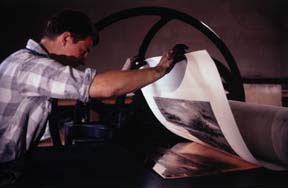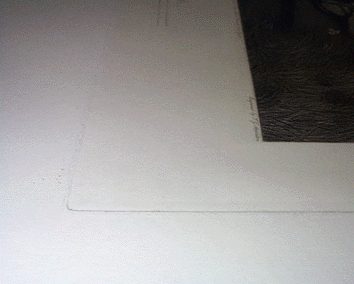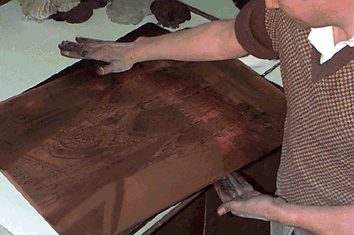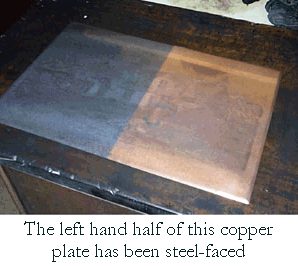
Printing
The art of hand printing from Intaglio, meaning incised or cut-in, plates has barely changed from the very earliest days of its development. To achieve a result that would satisfy both artist and engraver, the craft printer requires a tremendous depth of skill. He must assess the result that the artist and engraver or etcher planned to create, and mix inks in tone and consistency to suit the engraving, inking and wiping in a skilful manner to achieve the desired result.
(A detailed description of the process of plate printing follows this brief description.)
The production of each individual print requires the same attention to detail, as the plate must be inked, wiped, hand wiped & polished after each impression has been taken.
 Presses used for intaglio hand
printing have changed very little in
the last one hundred and fifty years.
Indeed some of the presses used
for these prints are of around that
age, and in the intervening years,
no reason has been found to alter
the basic design, which resembles
a greatly magnified clothes wringer!
Presses used for intaglio hand
printing have changed very little in
the last one hundred and fifty years.
Indeed some of the presses used
for these prints are of around that
age, and in the intervening years,
no reason has been found to alter
the basic design, which resembles
a greatly magnified clothes wringer!
Very high quality paper, made in Scotland exclusively for these prints, along with special intaglio inks, again produced specifically for plate printing, are essential in producing the "intaglio look & feel" which says you have something far more than "just another print", it is a true work of art !
 (Right) The 'plate mark' formed by
the edge of the printing plate is
clearly visible in this picture.
(Right) The 'plate mark' formed by
the edge of the printing plate is
clearly visible in this picture.
The plates used to produce these fine prints are highly coveted, and in view of
the irreplaceable nature of most plates, are treated with a justified loving care.
Some plates in the Thomas Ross Collection date back to the early years of
the eighteenth century, they are now about three hundred years old. These
precious plates are beautiful works of art in their own right. Many engraved
plates of the works of J M W Turner, John Constable, Sir Edwin Landseer and
other famous names, are a central feature of this unique collection.
Detailed description of the process of plate printing
Hand printing from Intaglio plates has not changed significantly from the earliest days of its development.
Specially formulated plate paper is first passed through a water trough and placed under moderate weight overnight to become evenly moist before printing. This dampening of the paper is essential so that it is supple enough to be pressed into the crevices of the plate to draw out the ink.
The craft printer must now assess the plate and mix an appropriate ink. Very few prints are produced with a "straight" black. Most utilise a mixture, imparting either a brown shade or sometimes a blue-black for a colder appearance. Numerous plates are printed in a warm sepia toned ink, and some classical subjects require the use of a sanguine (reddish brown) colour.
Before printing can begin, the ink must be mixed and adjusted to a consistency (or viscosity) that will suit the plate. Sometimes this requires a "stiffer" ink, and sometimes a "looser" (or "thinner") ink depending upon the holding properties of the lines in the plate.
The plate must be inked all over, either with a roller or with an implement called a "dabber" (this consists of a pad of cloth or leather mounted on a mushroom shaped handle, and is used to work in the ink on plates with very deep lines that will not readily accept ink from a roller.
When the whole image area of the plate (including the engraved title) has been covered with ink, the wiping stage can commence. Pads of stiffened muslin, referred to as canvas in this trade, (but nothing like canvas that one imagines) are used to steadily remove the surplus ink from the surface of the plate. It is interesting to note that while the inking technique will have at least partially filled the lines of the plate with ink, further ink is moved from the surface to the lines during the initial phase of wiping. As the printer changes to cleaner pads of muslin during wiping, the surface of the plate is cleared of ink, which remains only in the lines and crevices forming the design.
 The next and critical stage in printing, the hand wipe, is perhaps the most difficult part of copperplate printing to master. The printer must use the palm of his or her hand, with a little chalk, to remove the ink bloom (a trace or film of ink that evades wiping with a cloth) from the surface of the plate. Without this stage, the finished print would tend to be dull, and lacking in highlights. Equally if the hand wipe is not skilfully conducted, ink may be removed from the lines of the plate, spoiling the print.
The next and critical stage in printing, the hand wipe, is perhaps the most difficult part of copperplate printing to master. The printer must use the palm of his or her hand, with a little chalk, to remove the ink bloom (a trace or film of ink that evades wiping with a cloth) from the surface of the plate. Without this stage, the finished print would tend to be dull, and lacking in highlights. Equally if the hand wipe is not skilfully conducted, ink may be removed from the lines of the plate, spoiling the print.
After hand wiping is complete, the final preparation is to clean the edges and margins of the plate with a leather and the application of chalk to remove any traces of ink that may remain. Unless removed this would leave dirty marks on the finished print between the image and the all important plate mark (see later in this section to read more about the plate mark and its importance.)
After all inking, wiping, hand wiping and cleaning has been completed, the plate is placed face-up on the bed of a hand operated rolling-press. (see right)
A
sheet of the previously dampened paper is laid upon the face of the plate.
Using special felt blankets between paper and the roller of the press, the
machine is now wound by hand, the bed (or plank) carrying the plate, paper
and blankets between the rollers under great pressure. The force applied
causes the paper, pushed by the resilient blankets to be pressed into the
crevices of the plate, drawing out the ink they contain. An etching (or
engraving) is in the making.
The
printed sheet is now gently peeled from the plate, taking care not to
disturb the wet ink. Drying of both ink and paper now must be performed
between blotters and under heavy weight, so that the print will dry flat
and not wrinkle or cockle. Meanwhile the craft printer will return the
plate to the bench, and repeat the whole process from inking and wiping
for each individual print that is to be made. It is a time consuming
proces.
After the print has been dried, it may
be complete if it is to be be sold as a sepia, sanguine or
black and white print. Otherwise, it is ready for hand
water-colouring. Please refer to the hand colouring section.
We will now look at the "Plate mark", it's importance in intaglio prints, and what that means to the customer.
As mentioned earlier, the indentation left in the paper by the action of great pressure through the press is very important. It is generally regarded as the hallmark of an authentic etching or engraving, and if you know what to look for, sets this work apart from imitations. Sometimes a simulated plate mark is applied to prints produced by other (usually mechanised) printing methods, to produce the "appearance" of a hand printed etching or engraving. If one examines the plate mark of a genuine intaglio print, the paper surface within that mark will be smoother that the surrounding border, due to the great pressure applied on damp paper during printing. This difference is absent from simulated plate marks applied to other types of print, which would of course have been made on dry paper.
Throughout this page we have referred to copperplate printing. The methods used are equally relevant to printing from plates made of steel or other metals. (In times of high copper prices, Zinc has been used.)
In the earliest days of intaglio engraving and printing, almost all plates were engraved on copper, and suffered from the problem of rapid wear owing to the relative softness of copper. Around 1820, Thomas Lupton pioneered work with steel plates, and devised a workable method of first softening the steel before engraving, and hardening it afterwards. This revolutionised the art trade at the time, enabling many more prints to be produced from a given plate. Despite the softening step before engraving, steel is still a much more difficult metal to engrave, and so was not favoured by engravers at the time.
In the 1850's two Frenchmen named Garnier and Salmon, devised a solution to the problem of rapid wear or difficulty in engraving. Steel Facing or Acierage in French, was almost magical at the time, permitting a plate to be engraved on copper (the metal of choice) and then have the surface protected with an incredibly thin film of iron. The technique was initially a closely guarded secret and much prized by those that had access to it. As the method became more widely available, use of steel plates declined as engravers turned again to using copper.
 An amazing aspect of steel facing is that while protecting from wear it does not detract from the fine detail of the plate. This is partly due to the coating being as thin as two ten-thousandths of an inch. After a period of use, the facing (though called steel facing, it is actually iron) itself succumbs to wear; it is removed by careful use of acid, and a new layer applied. Steel facing has been in use at Thomas Ross for many years, and is vital in protecting both old and new copper plates from wear yet enabling them to be printed for us to enjoy.
An amazing aspect of steel facing is that while protecting from wear it does not detract from the fine detail of the plate. This is partly due to the coating being as thin as two ten-thousandths of an inch. After a period of use, the facing (though called steel facing, it is actually iron) itself succumbs to wear; it is removed by careful use of acid, and a new layer applied. Steel facing has been in use at Thomas Ross for many years, and is vital in protecting both old and new copper plates from wear yet enabling them to be printed for us to enjoy.
Storing copper, steel and steel faced plates correctly is vital to ensure no damage or corrosion takes place
due to condensation etc. When a plate has been used and is to be stored away the ink has to be completely
removed, handfuls of shredded leather has been found to be suitable for this, soaking up the residual ink yet not harming the plate. Then the plate is coated in wax to seal the surface. In the illustration to the left the printing plate is being heated ready to have wax rubbed all over the surface to seal it completely from any moisture. It will then be carefully wrapped and stored on edge in a fireproof safe along with many other plates.
|
||||||
|
|
||||||
Home | Cart | Search | Browse | About the prints | Etching | Printing | Paper | Colouring | Artist biographies | Full examples | Ordering | Discounts | Shipping | Guarantee | Testimonials | Thomas Ross website | Links | Contact | Privacy |
© 2003-2025 Website copyright Steve Bartrick, Images Copyright Thomas Ross Limited
Unauthorised reproduction is prohibited
Steve Bartrick Antique Prints and Maps